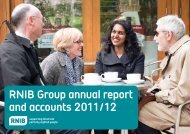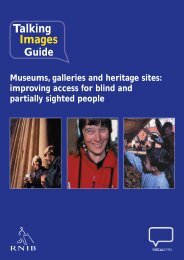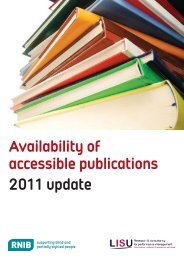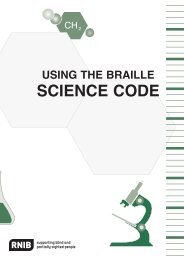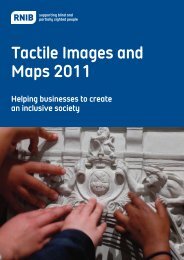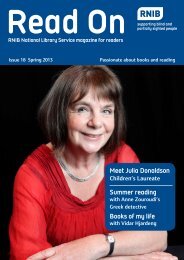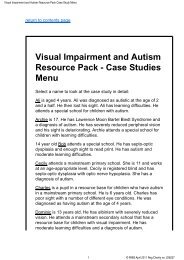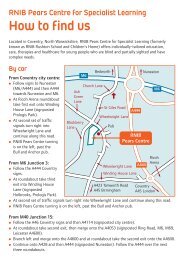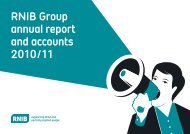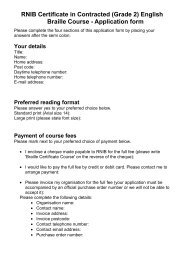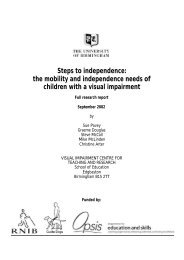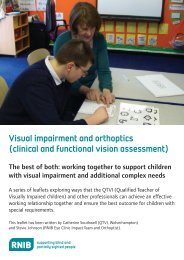Download Complete Report (PDF 1.19mb) - RNIB
Download Complete Report (PDF 1.19mb) - RNIB
Download Complete Report (PDF 1.19mb) - RNIB
You also want an ePaper? Increase the reach of your titles
YUMPU automatically turns print PDFs into web optimized ePapers that Google loves.
1. Radio and bind and partially sighted people – background<br />
that older participants (aged 75+) were more likely than younger participants to report<br />
not owning or listening to the radio.<br />
1.2. Range of radio content consumed<br />
Though their study was conducted before the advent of digital radio before there was<br />
the additional choice offered by digital radio, Bruce et al. (1991) reported that blind<br />
and partially sighted people listen to a broad range of content. Participants were asked<br />
which one radio station they listened to most out of BBC Radio 1, 2, 3, 4, local radio<br />
(BBC and commercial), local radio for blind people, and other. Across all participants,<br />
local radio, BBC Radio 2 and BBC Radio 4 were the three most often selected options.<br />
Preferences were broadly similar across all age groups, though there was a tendency for<br />
local radio to be preferred by younger participants.<br />
1.3. Range of stations listened to<br />
Bruce et al’s (1991) study also asked participants which of the radio stations from the<br />
above list they ever listened to. Overall, 50 per cent reported sometimes listening to<br />
local radio, 43 per cent to BBC Radio 2, 36 per cent to BBC Radio 4, and 15 per cent<br />
to both BBC Radio 1 and Radio 3. This pattern of results reflects the older age profile<br />
of blind and partially sighted people relative to that of the general UK population.<br />
Given that the number of stations available to listeners has increased substantially<br />
since their study, particularly with the advent of digital radio broadcasting, the findings<br />
of Bruce et al (1991) that blind and partially sighted people tend to listen to more<br />
than one radio station is particularly relevant background to the current research.<br />
1.4. Changing station with analogue radio equipment<br />
The study by Bruce et al (1991) explored how blind and partially sighted people<br />
reported that they change station to listen to a different radio station, using analogue<br />
radio equipment. They reported that 77 per cent of participants aged under 60 years<br />
and 62 per cent of those aged 75 years and above, changed station themselves.<br />
1.5. Confidence with technology<br />
For older participants, the extent of residual vision was observed to have an impact on<br />
whether they reported being able to change station themselves. The same effect was<br />
not observed in relation to younger participants. Whilst Bruce et al. (1991) did not<br />
make this explicit, this finding suggests that participants’ confidence in using their<br />
16



